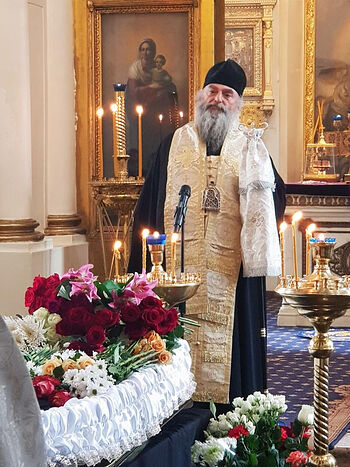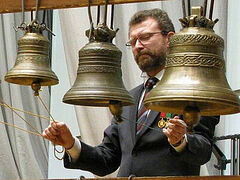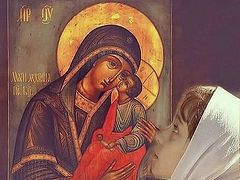The funeral service for Adolf Nikolaevich Ovchynnikov took place on March 19 at Moscow’s Church of “Joy of All Who Sorrow” Icon of the Mother of God on Bolshaya Ordynka Street. Vladyka Hilarion, who officiated at the funeral service, read a letter of condolence from His Holiness Patriarch Kirill and added a lot of useful and valuable words of his own.
Vladyka Nikoloz (Pachuashvili), Metropolitan of Akhalkalaki, Kumurdo, and Kars of Georgia, was present and prayed at the funeral. At the end of the service, he also delivered a truly warm fatherly address.
 Vladyka began by saying that it was God’s will that he be present in Moscow at the time. Had he been in Georgia, no matter how much he wanted to come and pay his last respects, he simply would not have had a chance to come, nor could he have arrived in time. Under the existing circumstances, he wouldn’t have been able to cross all the borders between our two countries quickly enough. However, at the time of Adolf Nikolaevich’s death, he was in Moscow, albeit for a wholly different reason. “Once I found out, the first thing I thought was that the Lord wished for someone from Georgia to pay our last respects before Adolf Nikolaevich, because our whole country was hugely indebted to him, and I was personally indebted to him as well.” We shall add that Vladyka and Adolf Nikolaevich were the namesakes, as the latter was baptized with the name of Nikolai.
Vladyka began by saying that it was God’s will that he be present in Moscow at the time. Had he been in Georgia, no matter how much he wanted to come and pay his last respects, he simply would not have had a chance to come, nor could he have arrived in time. Under the existing circumstances, he wouldn’t have been able to cross all the borders between our two countries quickly enough. However, at the time of Adolf Nikolaevich’s death, he was in Moscow, albeit for a wholly different reason. “Once I found out, the first thing I thought was that the Lord wished for someone from Georgia to pay our last respects before Adolf Nikolaevich, because our whole country was hugely indebted to him, and I was personally indebted to him as well.” We shall add that Vladyka and Adolf Nikolaevich were the namesakes, as the latter was baptized with the name of Nikolai.
Vladyka pointed out that, with his passing, a whole era of great relevance has come to an end not just for Russia and Georgia but also the Orthodox world as a whole. “For more than a quarter of a century, he lived at the caves basically saving the frescoes of the Gareja Hermitage, some of the most remarkable paintings among those that have survived in our country. They included frescoes that were practically lost, yet many of them remained in Adolf Nikolaevich’s creations, or their exact reproductions… I can’t recall an art restorer or a painter who wouldn’t have considered Adolf Nikolaevich their teacher.” Ovchinnikov brought up a whole generation of master artists during Soviet times, and many of them are Vladyka’s personal friends. A new school of art restoration and icon painting was founded based on Adolf Nikolaevich’s work. Vladyka was particularly grateful for the reposed artist’s ability to say only truly deep and thought-provoking things during their conversations.
“I would like to say a prayer,” said the Georgian elder in the end, “and thank the Russian people for bringing such a great man into the world, as he made an inestimable contribution to the development of our culture, the bilateral relationships between our two countries, and for the future.
May the Lord give rest to his soul!”
I was greatly amazed by the story about the frescoes and the caves. It’s even hard to imagine today how someone could have done it during those years. An eccentric, living in the Georgian caves, who for no apparent reason paints reproductions from the abandoned frescoes. He stayed in an area inhabited many centuries before by Christian ascetics, a place where the Divine Liturgy was served. He is a Russian man named Adolf. It all sounded like a story taken from either the Ancient Patericon or Tarkovsky’s “Andrey Rublev.” At the same time, the builders of communism in Tbilisi and Moscow marched on in their May Day demonstrations.
Later, I learned from his relatives that from the end of the 1960s to the early 1970s and to the end of the 1980s, Ovchinnikov went to Georgia annually, spending three months there redrawing the frescoes. He worked in Betania, Ateni, Achi, David-Gareja, and other places. His Georgian students of the time have become big names and well-known scientists, professors and the doctors of science. From 1971 to 1983, he taught a redrawing technique class at the Institute of Georgian Art, and his students used to come to him in Russia for a practical training course.
When I heard Vladyka Nikoloz say that Adolf Nikolaevich lived in the caves with fresco paintings, a thought suddenly crossed my mind how the artist had spent the last year of his life in just that sort of a cave. Truly, his tiny apartment in a multistoried apartment building at Bolshaya Spasskaya, packed full of paintings, copies, artifacts, and books, looked much like the cave of a desert dweller. Once you got inside, you were immersed in an otherworldly reality of a long-gone era that simply had no place anymore outside his apartment’s closed doors in that bustling city of Moscow. He was lying there in his “cave”, preparing to depart this life, surrounded by a very small cohort of devoted people. He was surrounded by icons and angels casting their eyes upon him from the fresco copies and the icons he painted and restored. This apartment cum cave was like an ancient, dilapidated church having a mix of things put together: frescoes and teapots, medicine and candles, bread and icons, crosses, books, magazines, thermometers, and traveling icon triptychs. There were holy icons all around. He used to see the priests there, in the cave, and like an ancient ascetic, he barely spoke a word with those who administered the Holy Mysteries of Christ to him.
Despite his terminal illness, he communed quite consciously. It was noticeable from his physical condition what effect the grace of God had on him and how he, almost completely detached from the outside world, waited and longed for it to happen. He was well aware of it and understood what was going on. He would, if you will, resurface from that “inner” world of his, eagerly partaking of this fountain of grace.
We visited him for the first time on the feast day of St. Demetrios of Thessaloniki on November 8, 2019. His former student and assistant, an old friend of mine, asked me to come and arranged everything. As we travelled to Adolf Nikolaevich’s apartment, I learned that no one knew when he had last communed, while his international fame and a frail state of health promised certain complications to our enterprise that could easily result in failure. At the same time, we did receive general consent for a priestly visitation. Once we entered his “cave”, I saw a feeble old man wrapped in a woolen throw, lying beneath a large fresco painting.
“Hello, Adolf Nikolaevich! Demetrios of Thessaloniki has sent me to you and we are going to receive Communion!”
“Yes, yes,” he came alive and nodded approvingly without the slightest shadow of dismay or a doubt. At that moment, the name Demetrios of Thessaloniki sounded like the name of a senior family member. He got up with assistance. Later on, he made his best effort to have confession and we solemnly administered Communion to him. He was even able to walk a bit, and joined us when we went to the kitchen and had tea.
 By the time of our next visits, his illness had taken its toll and we no longer had tea together. However, every time we came he looked as if frozen in a vegetative state, but when the time came for Communion, he would all of a sudden come alive again. It was obvious how much he longed for it to happen and desired to have it. His whole being grew brighter and livelier after partaking of the Holy Mysteries.
By the time of our next visits, his illness had taken its toll and we no longer had tea together. However, every time we came he looked as if frozen in a vegetative state, but when the time came for Communion, he would all of a sudden come alive again. It was obvious how much he longed for it to happen and desired to have it. His whole being grew brighter and livelier after partaking of the Holy Mysteries.
When I once shared to my friend, an icon painter, that we gave Communion to Ovchinnikov, he was greatly surprised upon hearing it, because, as he said, Adolf Nikolevich didn’t like the Church and criticized it, etc. Besides, it turned out, he wasn’t particularly fond of us monks back in the time when he was in good health and full of vigor. I can’t tell why, since I simply don’t know. Generally speaking, it’s not such a rare thing in the world of creative professionals: art critics, restorers, museum workers, architects, and scientists. It does happen among those whose professional activities have to do with Church art and Christian heritage. Even though their lives were spent around the holy sites, they didn’t treat “the men in cassocks” too well, disliking and criticizing them. They can say truly unflattering things to practically anyone. It is a rather widespread phenomenon. I am not sure how it was exactly with Adolf Nikolaevich, but it seemingly did happen one way or another. Those who knew him well back in soviet times were genuinely surprised, and rejoiced at the news that he had begun to partake of Communion.
As for me, I received a truly special personal experience I never had before.
It was so on the last day of his earthly sojourn, on April 14, the commemoration day of St. Mary of Egypt. Looking frail and emaciated, on the verge of crossing the line between this and the heavenly worlds, the servant of God Nikolai was fully aware of what was going on and partook of the Body and Blood of Christ for one last time, only to depart to his Heavenly Father in a few short hours.
***
P.S. Adolf Nikolayevich once shared that during his early childhood, he was taken care of by his grandfather, a forest ranger. It was his grandpa who had him baptized with the name of Nikolai. Ever since he was three years old, his grandpa would read the Scripture to him, commenting on what was read in great detail. Adolf Nikolaevich considered reading Holy Scripture to be a basic necessity, and it greatly grieved him that people hardly ever read it or never read it enough.








